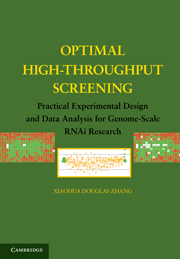 Optimal High-Throughput Screening
Optimal High-Throughput Screening Book contents
- Frontmatter
- Contents
- Preface
- Acknowledgments
- Acronyms and Abbreviations
- Part I RNAi HTS and Data Analysis
- 1 Introduction to Genome-Scale RNAi Research
- 2 Experimental Designs
- 3 Data Display and Normalization
- 4 Quality Control in Genome-Scale RNAi Screens
- 5 Hit Selection in Genome-Scale RNAi Screens without Replicates
- 6 Hit Selection in Genome-Scale RNAi Screens with Replicates
- Part II Methodological Development for Analyzing RNAi HTS Screens
- References
- Index
- Plate section
4 - Quality Control in Genome-Scale RNAi Screens
Published online by Cambridge University Press: 03 May 2011
- Frontmatter
- Contents
- Preface
- Acknowledgments
- Acronyms and Abbreviations
- Part I RNAi HTS and Data Analysis
- 1 Introduction to Genome-Scale RNAi Research
- 2 Experimental Designs
- 3 Data Display and Normalization
- 4 Quality Control in Genome-Scale RNAi Screens
- 5 Hit Selection in Genome-Scale RNAi Screens without Replicates
- 6 Hit Selection in Genome-Scale RNAi Screens with Replicates
- Part II Methodological Development for Analyzing RNAi HTS Screens
- References
- Index
- Plate section
Summary
Introduction
High-quality RNAi HTS assays are critical in genome-scale RNAi research. The development of high-quality RNAi HTS assays requires the integration of both experimental and computational approaches for quality control (QC). Three important means of QC are (i) good plate design, (ii) the selection of effective positive and negative biological controls, and (iii) the development of effective QC metrics to measure the degree of differentiation so that assays with inferior data quality can be identified.
Plate design and the design of effective controls are described in Chapter 2. A good plate design helps to identify systematic errors (especially those linked with well position) and determine what normalization should be used to remove/reduce the impact of systematic errors on both QC and hit selection. Section 2.3 presents multiple effective plate designs and guidelines; more information is available in Zhang. In this chapter, the development of effective QC metrics and the use of effective QC criteria are discussed, and the use all three QC processes to improve data quality in genome-scale RNAi screens is demonstrated.
Quality Assessment Metrics
Effective analytic QC methods serve as a gatekeeper for excellent quality assays. In a typical HTS experiment, a clear distinction between a positive control and a negative reference such as a negative control is an index for good quality. Many quality assessment measures have been proposed to measure the degree of differentiation between a positive control and a negative reference.
Information
- Type
- Chapter
- Information
- Optimal High-Throughput ScreeningPractical Experimental Design and Data Analysis for Genome-Scale RNAi Research, pp. 42 - 61Publisher: Cambridge University PressPrint publication year: 2011